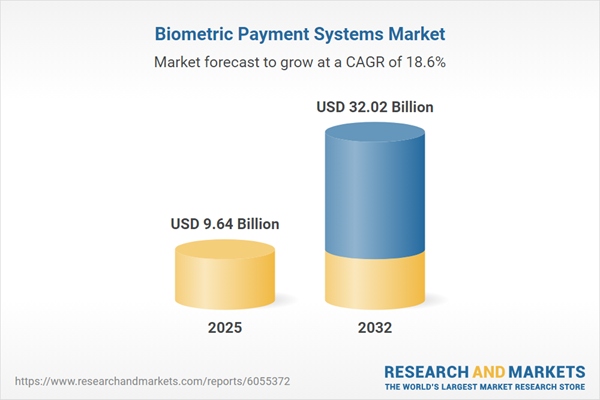Speak directly to the analyst to clarify any post sales queries you may have.
Biometric payment systems are increasingly integral to secure, seamless digital transactions, fostering greater confidence in both customer-facing and enterprise payment infrastructures. Senior decision-makers must assess this evolving landscape to position for resilience, efficiency, and compliance in a dynamic market trajectory.
Market Snapshot: Biometric Payment Systems Market Overview
The Biometric Payment Systems Market grew from USD 8.20 billion in 2024 to USD 9.64 billion in 2025. It is anticipated to maintain strong momentum at a CAGR of 18.55%, ultimately reaching USD 32.02 billion by 2032. This growth is propelled by adoption in financial services, retail, and mobile payment environments as organizations seek enhanced security, operational efficiency, and improved consumer experience through biometric authentication integration.
Scope & Segmentation
This report provides actionable intelligence across the entire biometric payment systems value chain. Strategic segmentation supports nuanced decision-making, encompassing:
- Components: Hardware such as biometric sensors, capture and authentication devices, and edge processing units; software including matching and recognition platforms, identity management, and payment processing integration.
- Technology: Behavioral biometrics, face recognition (2D, 3D, infrared), fingerprint recognition (capacitive, optical, ultrasonic), iris recognition, palm vein, and voice authentication.
- Authentication Type: Multi-factor and single-factor authentication approaches, balancing security with user experience.
- Application: ATM transactions, mobile payment and digital wallet systems, point-of-sale environments.
- Enterprise Size: Solutions for large enterprises and small to medium enterprises, reflecting diverse procurement and deployment practices.
- End-User Industry: Banking and financial services, education, government, healthcare (hospitals, clinics, pharmacies), hospitality (hotels, restaurants, theme parks), retail (department stores, specialty, grocery, quick service), and transportation & logistics (airlines, fuel stations, public transit).
- Regions Covered: Americas (with breakout for US, Canada, Mexico, Brazil, Argentina, Chile, Colombia, Peru), Europe, Middle East & Africa (including UK, Germany, France, Russia, Italy, Spain, Netherlands, Sweden, Poland, Switzerland, UAE, Saudi Arabia, Qatar, Turkey, Israel, South Africa, Nigeria, Egypt, Kenya), Asia-Pacific (China, India, Japan, Australia, South Korea, Indonesia, Thailand, Malaysia, Singapore, Taiwan).
- Companies Profiled: Amazon Web Services, Apple, Aratek Biometrics, Aware, Clear Secure, Cognitec System, DERMALOG Identification Systems, Fingerprint Cards AB, Fujitsu, HID Global Corporation, Hitachi, IDEMIA Group, IDEX Biometrics ASA, Infineon Technologies AG, Innowise, JPMorgan Chase, Mastercard, NEC Corporation, NXP Semiconductors, Panasonic, Samsung Electronics, Thales Group, Visa, Worldline, among others.
Key Takeaways for Senior Decision-Makers
- Rapid advances in biometric sensors, on-device processing, and modular software drive adoption, enabling privacy-focused and decentralized authentication that aligns with evolving regulatory expectations.
- Open APIs, tokenization, and federated identity frameworks support seamless integration across payment channels, reducing disruption and accelerating time-to-market for banks, retailers, and payment processors.
- Regional adoption varies due to contrasting regulatory priorities, local supply chain maturity, and consumer familiarity. Areas such as unbanked markets and developed digital economies present divergent deployment paces and risk profiles.
- Strategic supplier diversification and modular system design mitigate trade policy risks and support adaptability in procurement, especially given tariff impacts on critical hardware components.
- Successful pilots, scalable implementation models, and robust lifecycle device management are critical to achieving operational resilience and defending against security vulnerabilities.
Tariff Impact on the Biometric Payment Systems Supply Chain
US tariff measures enacted in 2025 have redefined procurement and supplier strategies throughout the biometric payments ecosystem. Tariffs affecting specific hardware imports have driven shifts toward alternative manufacturing sources, cost-passing to buyers, and migration of functions to software, which is less exposed to trade regulation. Organizations with diversified or vertically integrated suppliers have maintained cost stability, while others prioritize sourcing flexibility and supply chain risk mitigation.
Methodology & Data Sources
This analysis leverages primary interviews with industry experts such as solution architects and procurement officers, as well as secondary research from technology and payments resources. Rigorous vendor capability mapping, scenario-based policy impact assessments, and segmentation alignment strategies reinforce the operational validity of the findings.
Why This Report Matters
- Supports risk-aware planning by providing granular insights into market evolution, regional contrasts, and technology adoption dynamics.
- Enables informed investment and procurement decisions tied to privacy-enhancing practices, future-proof technology segmentation, and supplier diversification for enterprise deployment.
- Empowers leaders to adapt strategies for compliance, scalability, and customer trust as biometric payment systems move from pilot projects to mainstream rollout.
Conclusion
Biometric payment systems are becoming foundational across global payment environments. Senior leaders equipped with actionable insights can navigate market complexity, align with compliance needs, and drive secure, scalable rollouts that deliver lasting value.
Table of Contents
3. Executive Summary
4. Market Overview
7. Cumulative Impact of Artificial Intelligence 2025
Companies Mentioned
The companies profiled in this Biometric Payment Systems market report include:- Amazon Web Services, Inc.
- Apple Inc.
- Aratek Biometrics
- Aware, Inc.
- Clear Secure, Inc.
- Cognitec System, GmbH
- DERMALOG Identification Systems GmbH
- Fingerprint Cards AB
- Fujitsu Limited
- HID Global Corporation
- Hitachi, Ltd.
- IDEMIA Group
- IDEX Biometrics ASA
- Infineon Technologies AG
- Innowise Sp. z o.o
- JPMorgan Chase & Co.
- Mastercard Incorporated
- NEC Corporation
- NXP Semiconductors N.V.
- Panasonic Corporation
- Samsung Electronics Co., Ltd.
- Thales Group
- Visa Inc.
- Worldline S.A.
Table Information
| Report Attribute | Details |
|---|---|
| No. of Pages | 197 |
| Published | November 2025 |
| Forecast Period | 2025 - 2032 |
| Estimated Market Value ( USD | $ 9.64 Billion |
| Forecasted Market Value ( USD | $ 32.02 Billion |
| Compound Annual Growth Rate | 18.5% |
| Regions Covered | Global |
| No. of Companies Mentioned | 25 |









